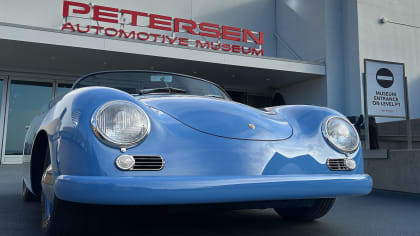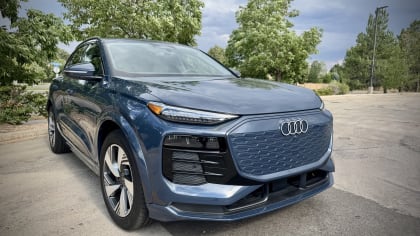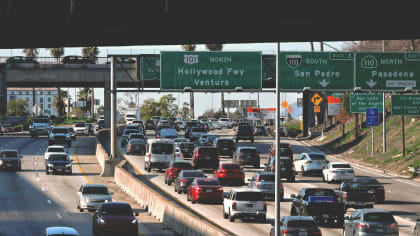THE MAVTV 500 STORY
Heroes Who Are Gods
This article is from our archives and has not been updated and integrated with our "new" site yet... Even so, it's still awesome - so keep reading!
Published on Sun, Jun 28, 2015
By: The LACar Editorial Staff

Story by Brian Kennedy, PhD
Photography by Gabriela Moya
“Do you want to race or don’t you?” That was the question Dale Earnhardt posed in an interview given to ESPN shortly before he was killed at Daytona in 2001. He said it in response to the suggestions fans and media were making that NASCAR racing was getting too fast, and thus too dangerous.
Ed Carpenter said essentially the same thing in a tweet cited in Tony Kanaan’s press conference in Fontana Saturday afternoon following the MAV TV 500. The tweet went like this: “I love close IndyCar racing. Hate to see drivers bad mouthing a series. If you want to race, race. If not, retire.”
Hearing this ignited a fire in runner-up Kanaan, who said to the reporter who had read the tweet out, “Are you risking your life out there? You’re not. You’re sitting in a chair and writing about it.”
He was responding not only to the comment but also the events of the day, which had seen a 23-car field run wheel-to-wheel at more than 220 mph at Auto Club Speedway in Fontana.
Not was fine for you guys, that’s for sure. It was a little crazy for us. I tried to stay in the front all day, to stay out of trouble. It was a little bit of a closer race than we expected it to be. But at the end, we all survived. It was very stressful.”
He then went a little bit further before the already-cited outburst. His second comment was: “It’s a fine line. It’s definitely a fine line. I think [inaudible] the fans must be loving it, so hopefully we can pack this place when we come back if we’re going to keep racing like this. But for us, you know, people have to understand how stressful it is. Obviously, we get paid, and we are who we are, because we can do this, but we can’t forget that we lost, I lost my best friend in 2011, and so I understand what the fans want, and if you say we’re going to have 100,000 people here I might agree with you that we need to put it out there. But to have 5,000 people here and do this, it’s too big.”
And he finished his comments to the reporter who had referenced Carpenter with these words: “So once you feel this way, and you lose your best friend, you might say something like that. I have an opinion and this is my opinion, so I hope you respect that.”
Kanaan’s opinion is to be respected, and he’s right that the risk-reward equation, when tipped to risk, brings out fans. But he’s wrong in his example which equates Fontana’s close racing to the events which led to Dan Wheldon’s death in 2011. And his suggestion that risk is tolerable if enough fans are in place to watch seems to go counter to his claim, implied but clear, that he isn’t interested in racing the way the Verizon IndyCars did on Saturday.
Yet despite his emotion, Kanaan raises several salient questions. First is that of the relationship between good racing and the risks to drivers. Then there’s Wheldon. And finally, who is responsible for what happens on track?
Let’s begin with excitement and the risk of death. It an issue that every fan of motorsports has to reckon with. I’ve been covering the sport for more than 20 years, and I’ve been a fan of many racers who have died—Jovy Marcelo, Neil Bonnett, Adam Petty, Earnhardt, Kenny Irwin, Gonzalo Rodriguez, Greg Moore, and on and on.
At one point a few years ago, it got to be so many had died that I sat down and had a serious think about this pastime/hobby/side job of writing about racing. Was it worth it? None of these deaths served any purpose at all, truth be told. So why be party to them via promoting the sport as a journalist? I almost gave it up. But I decided to keep on for what I think is exactly what Kanaan is skirting around in his comments.

Said simply, being close to death is what puts racers close to being gods. They do what they do precisely because none of the rest of us can, through lack of either skill or will. I don’t want to see them die, but watching them race on the very edge of control is what makes them amazing. Only a few people in the world could take a car and get it to max adhesion—which means, on the edge of loss of control—and do that at 226mph, which is the speed drivers were running into turn 1 in Fontana.
Graham Rahal, Saturday’s winner, expounded on the danger: “Those [fans] who came, I think they got quite a show.” The nuance, or the sense of disappointment—that there weren’t many of them—did not have to be explained. “It was pretty entertaining. Sure, from a driver’s perspective, it was pretty nerve-wracking at times. I was going four wide outside of Kanaan, I think, [and] maybe Briscoe or someone, and I was thinking, ‘I haven’t done this in years and years’ but the thing was, like I just said, here versus Texas, the difference is the width of the place. Plus, the guys were able to stay in the lanes and make it consistent and fun, so I always felt like when I went there, I was going to be given some room and make the racing pretty good.”
What you don’t see there is the sense of panic, if that’s not too strong a word, that you get with Kanaan, which brings us back to him and his second point, which is what I see as an inaccuracy in citing a friend’s death. That friend was Dan Wheldon, a racer I also admired and followed. Warning: If you don’t like to be offended, stop reading now. If you’re still with me, listen to this: Kanaan’s equating of Wheldon’s death with the danger of racing Fontana this year is flat nonsense.
Dan Wheldon, much as I mourned his death, was entirely responsible for what happened to him. He was racing despite not having run the full season. He was chasing a bonus of a million dollars. And he died by running up the back of another car trying to cheat a yellow flag when an accident happened in front of him. Watch the video on YouTube for yourself. There’s a lot of smoke and a lot of warning. He should have slowed down. This accident in no way resembles anything that might have happened, but fortunately didn’t, in Fontana on Saturday due to the aero kit. But here we have the real crux of Kanaan’s argument.
Kanaan’s point, more down to earth, is not that racing should be entirely safe. More like that it shouldn’t be up to the sanctioning body to set terms which make the racing as unsafe as he, and others, felt it was on Saturday in Fontana.
The proof of the danger in Saturday’s race was evident in every lap. All it takes is a flick of the wrist the wrong way in those circumstances, and it’s disaster. And the reason for that? IndyCar sets the terms of the aero package drivers use, and in this case, they provided so much downforce that the cars could run this close because they had incredible grip. But what the sanctioning body can’t do is govern driver behavior.

Rahal expounded on this: “Kanaan was pushing me down to the white line, but the thing with a guy like TK is that when it comes to corner entry, you know he’s going to give you your space, which is what happened the last couple of laps there. But there were guys like Sato, [who] was going into one, on the bottom and would just shoot straight to the top of the track. You’re like, ‘Where the hell did that come from?’ Unfortunately, we’re being told to give room and stuff, but nobody is, and yet there’s no penalties for it. So when I was being pushed around, I don’t feel that it’s right to be pushed around, so I just pushed back, and that’s how it goes.”
Yet Kanaan pointed directly to the aero package set by the series. “I think for sure IndyCar is going to think about it. We’re going to talk among ourselves, among the drivers, and at the end of the day, we’re the ones driving. We’re going to give our opinion.” He paused, changing course apparently. “Because . . . the last time we talked, we lost a hell of a guy, and I would hate to see something like that ever again.”
If you don’t see a driver’s union/rebellion in that, you don’t know enough about motorsports history. In F1 back in the 1960s, Jackie Stewart became a safety advocate after an accident at Spa nearly killed him and exposed the total lack of regard for driver safety in F1 in the aftermath of a wreck. In the late1960s and early 70s, he organized several boycotts until safety measures at F1 tracks were improved.
In NASCAR, in 1969, drivers went on strike over safety concerns at the newly opened track in Talladega, Alabama. Richard Petty was among them. The answer? Bill France, Sr. simply told them if they didn’t want to race, not to, and added to the field with fringe drivers. This may have been where the phrase “Son, you need NASCAR a lot more than NASCAR needs you” originated. If not, it surely fits the bill.
The death of Neil Bonnett in practice at Daytona in 1994 surely should have prompted a similar action. He had a blowout in a year when there was a tire war in the series, with Goodyear being challenged by Hoosier and both companies pushing it too far. Lesser-known driver Rodney Orr was also a casualty of this situation. As it was, Hoosier withdrew from competition, and the series has used one tire company ever since.
These days, obviously, safety is very much a cooperative effort, and tracks are making moves to install barriers which crush easily, fencing, and on and on, not to mention having improved their emergency services to the point where you’d rather have an accident at an IndyCar race than on any highway you can name.
But the best-laid plans, well, they go awry. Dario Franchitti was injured and put out of racing in 2013 at the end of the Houston street race when he went into the catch fence and suffered a broken back and a concussion, among other injuries.
So no, racing will never be safe. And if it were, it would be boring. Let’s be honest. Part of what has taken the thrill from NASCAR is that the tracks are almost entirely surrounded by soft walls. It’s like bumper cars.
But that’s verging on the politically incorrect again, sounding like I want to see people get hurt. I don’t, but I love racing, in part, the way I love boxing. I recognize that I could never do it with any degree of proficiency, and if they make it so safe that I could do it, then I wouldn’t need to watch other people do it, and neither would you.
Along with the danger come the thrills, and Fontana 2015 offered those on every lap. This was the best race I’ve ever seen, and I’ve seen a lot of them, including some incredible barnburners the past few years when IndyCar has been run under the lights to end the season at this same speedway. I’ve been to Laguna Seca, Indy, Mid-Ohio, Long Beach, Michigan, and even driven Watkins Glen, and I’ve never, ever wanted a race not to end. That’s what it felt like at Fontana on Saturday.
Ten cars could have won. Almost every lap it felt like a different one would. And you just wanted it to go on forever. If there’s racing in heaven, this is exactly what it’s going to be like. Who is responsible for that? Those who set the rules package, and those who have the guts to exploit it as drivers.
So in the end, and I imagine this was not his intention, my vote is to not let Kanaan’s rant take away from what was perhaps the best day of racing—of any form—we’ve seen in a decade, yet saying that comes with the admission that part of the greatness of this race was its closeness. That is to say, its danger, and this is under siege if Kanaan’s warning shot means anything.
What will happen? Well, IndyCar is free and clear for this year, with only three more ovals, none huge like the Auto Club Speedway. The aero rules thus are unlikely to create such tight, high-speed racing again this season. But before they return to the Fontana track, there will be talks.
Again Kanaan: “To be honest with you, it’s nobody’s fault. We can’t say we chose the right or the wrong aero package because this is [inaudible]. We went to Texas and it was OK, but I heard a lot of criticism about it being a boring race. So like you said, I don’t have the answer. How can we make it so we can keep the drivers happy and the fans happy? I really don’t [know]. I wish we, over the course of this year, we can come up with something that will be a compromise for both of us. Now, I really don’t know what to think.”
But after this, he backed down as his press conference wound down: “We’re professional race car drivers. Whatever the package you’re going to give us, we’re going to go out and do it. I think whoever doesn’t want to do it, won’t jump in the car.”
His final thoughts were, “To me, it was definitely a nerve-wracking race, but to me everything at the race track is fun, so I’ll definitely do it. But to me, things that I don’t like, I think it’s again, I think it was a heck of a show for the fans.” So here, he’s backed all the way down.

Race winner Rahal had a more balanced approach to offer: “I think it’s racing, you know. We have taken ourselves to a place over the past few years where we reduced downforce so far, um, that we couldn’t even race. It became a single file, follow the leader fest, and no, I don’t think it needed to be quite as close as it was today. People who sit and say it’s easy today, they should have beaten me, then, because I can tell you that it wasn’t easy for me. It was very hard to figure out where to go. The wake of a Honda was different from the wake of a Chevy. You had to be thinking, ‘Who am I behind? Can I find the grip? Do I need to straddle the seam?’ It wasn’t easy by any means, but it was the closest racing we’ve seen in a long, long time. It was very different from the old pack racing style.” So for you fans who missed it, there are two takeaways: don’t miss another, but don’t expect the next one to be this crazy, if Kanaan and whoever else bands with him gets their way when this is reviewed, which he said it would be. What do fans want? They want their heroes to be gods. Hopefully a year from now in Fontana, they’ll still have that chance. Race Notes Rahal has not won since 2008. He’s been fast all year though. Think that has anything to do with hanging around with Courtney Force of the drag racing family? They are engaged. Fourteen drivers finished on the lead lap. Two drivers had a scary collision coming out of turn four with a lap to go, Briscoe and Hunter-Reay. This brought out the yellow and ended the race. The highest rookie finisher was Sage Karam, in fifth. He, like a handful of others aside from Rahal, could have won the race. Had there been one more green lap, Kanaan might well have bested Rahal for the win. The series next goes to Milwaukee for the famous Mile there, running July 12th. Read Brian Kennedy’s Speeding on Route 66 to the Verizon IndyCar Series in Fontana Read Brian Kennedy’s MAVTV 500 IndyCar Qualifying story [nggallery id=mavtv2015]




